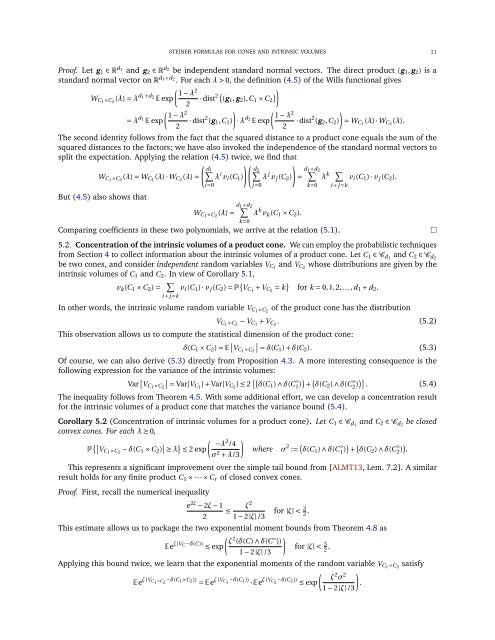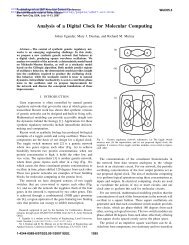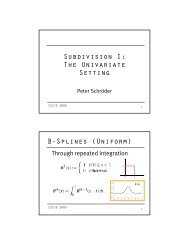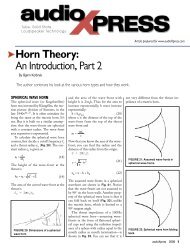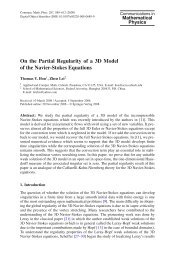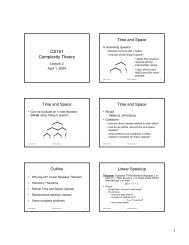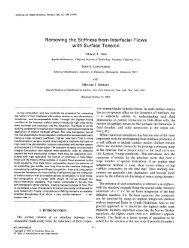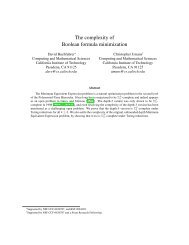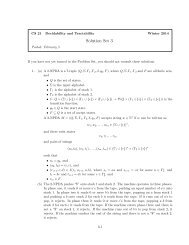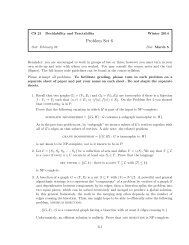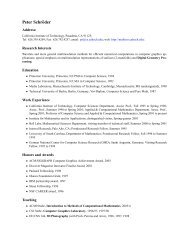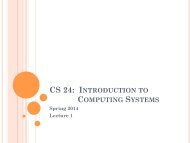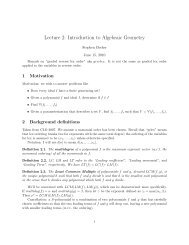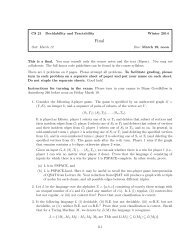From Steiner formulas for cones to concentration of intrinsic volumes
From Steiner formulas for cones to concentration of intrinsic volumes
From Steiner formulas for cones to concentration of intrinsic volumes
You also want an ePaper? Increase the reach of your titles
YUMPU automatically turns print PDFs into web optimized ePapers that Google loves.
STEINER FORMULAS FOR CONES AND INTRINSIC VOLUMES 11Pro<strong>of</strong>. Let g 1 ∈ R d 1and g 2 ∈ R d 2be independent standard normal vec<strong>to</strong>rs. The direct product (g 1 , g 2 ) is astandard normal vec<strong>to</strong>r on R d 1+d 2. For each λ > 0, the definition (4.5) <strong>of</strong> the Wills functional gives(W C1 ×C 2(λ) = λ d 1+d 2 1 − λ2E exp · dist 2 ( ) )(g 1 , g 2 ),C 1 ×C 22(= λ d 1 1 − λ2) (E exp · dist 2 (g 1 ,C 1 ) · λ d 2 1 − λ2)E exp · dist 2 (g 2 ,C 2 ) = W C1 (λ) ·W C2 (λ).22The second identity follows from the fact that the squared distance <strong>to</strong> a product cone equals the sum <strong>of</strong> thesquared distances <strong>to</strong> the fac<strong>to</strong>rs; we have also invoked the independence <strong>of</strong> the standard normal vec<strong>to</strong>rs <strong>to</strong>split the expectation. Applying the relation (4.5) twice, we find thatW C1 ×C 2(λ) = W C1 (λ) ·W C2 (λ) =But (4.5) also shows that(d1∑λ i v i (C 1 )i=0)∑λ j v j (C 2 ))(d2j =0d 1 ∑+d 2W C1 ×C 2(λ) = λ k v k (C 1 ×C 2 ).k=0∑d 1 +d 2=k=0Comparing coefficients in these two polynomials, we arrive at the relation (5.1).λ k∑i+j =kv i (C 1 ) · v j (C 2 ).5.2. Concentration <strong>of</strong> the <strong>intrinsic</strong> <strong>volumes</strong> <strong>of</strong> a product cone. We can employ the probabilistic techniquesfrom Section 4 <strong>to</strong> collect in<strong>for</strong>mation about the <strong>intrinsic</strong> <strong>volumes</strong> <strong>of</strong> a product cone. Let C 1 ∈ C d1 and C 2 ∈ C d2be two <strong>cones</strong>, and consider independent random variables V C1 and V C2 whose distributions are given by the<strong>intrinsic</strong> <strong>volumes</strong> <strong>of</strong> C 1 and C 2 . In view <strong>of</strong> Corollary 5.1,v k (C 1 ×C 2 ) =∑v i (C 1 ) · v j (C 2 ) = P { V C1 +V C2 = k } <strong>for</strong> k = 0,1,2,...,d 1 + d 2 .i+j =kIn other words, the <strong>intrinsic</strong> volume random variable V C1 ×C 2<strong>of</strong> the product cone has the distributionV C1 ×C 2∼ V C1 +V C2 . (5.2)This observation allows us <strong>to</strong> compute the statistical dimension <strong>of</strong> the product cone:δ(C 1 ×C 2 ) = E [ V C1 ×C 2]= δ(C1 ) + δ(C 2 ). (5.3)Of course, we can also derive (5.3) directly from Proposition 4.3. A more interesting consequence is thefollowing expression <strong>for</strong> the variance <strong>of</strong> the <strong>intrinsic</strong> <strong>volumes</strong>:Var [ V C1 ×C 2]= Var[VC1 ] + Var[V C2 ] ≤ 2 [( δ(C 1 ) ∧ δ(C ◦ 1 )) + ( δ(C 2 ) ∧ δ(C ◦ 2 ))] . (5.4)The inequality follows from Theorem 4.5. With some additional ef<strong>for</strong>t, we can develop a <strong>concentration</strong> result<strong>for</strong> the <strong>intrinsic</strong> <strong>volumes</strong> <strong>of</strong> a product cone that matches the variance bound (5.4).Corollary 5.2 (Concentration <strong>of</strong> <strong>intrinsic</strong> <strong>volumes</strong> <strong>for</strong> a product cone). Let C 1 ∈ C d1 and C 2 ∈ C d2 be closedconvex <strong>cones</strong>. For each λ ≥ 0,P {∣ ∣ VC1 ×C 2− δ(C 1 ×C 2 ) ∣ (} −λ 2 )/4≥ λ ≤ 2 expσ 2 where σ 2 := ( δ(C 1 ) ∧ δ(C1 ◦ + λ/3)) + ( δ(C 2 ) ∧ δ(C2 ◦ )) .This represents a significant improvement over the simple tail bound from [ALMT13, Lem. 7.2]. A similarresult holds <strong>for</strong> any finite product C 1 × ··· ×C r <strong>of</strong> closed convex <strong>cones</strong>.Pro<strong>of</strong>. First, recall the numerical inequalitye 2ζ − 2ζ − 1≤2 1 − 2|ζ|/3ζ 2<strong>for</strong> |ζ| < 3 2 .This estimate allows us <strong>to</strong> package the two exponential moment bounds from Theorem 4.8 as(Ee ζ(V C ζ −δ(C)) 2 (δ(C) ∧ δ(C ◦ )))≤ exp<strong>for</strong> |ζ| < 31 − 2|ζ|/32 .Applying this bound twice, we learn that the exponential moments <strong>of</strong> the random variable V C1 ×C 2satisfy(Ee ζ(V C 1 ×C 2 −δ(C 1 ×C 2 )) = Ee ζ(V C 1 −δ(C 1 )) · Ee ζ(V C 2 −δ(C 2 )) ζ 2 σ 2 )≤ exp.1 − 2|ζ|/3□


